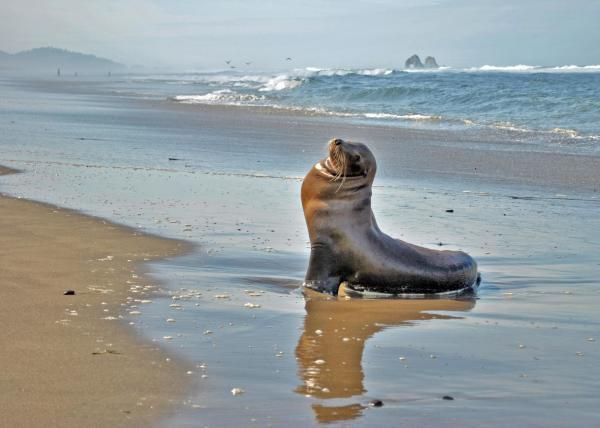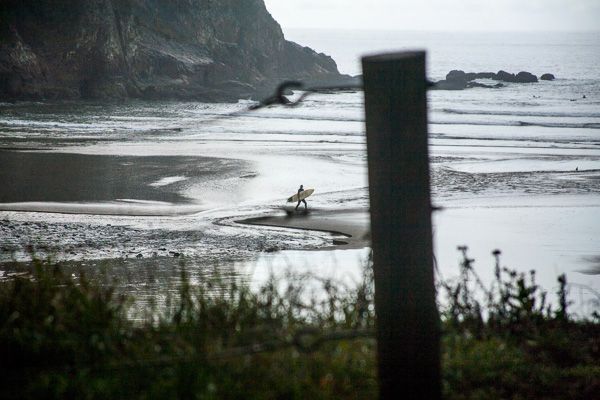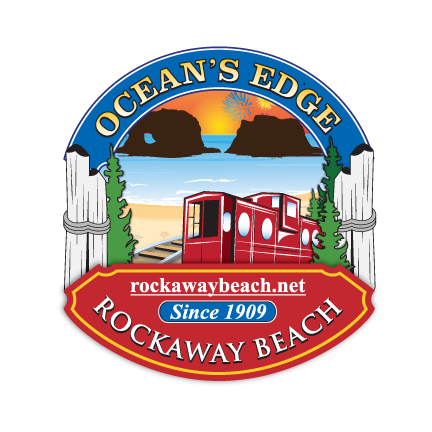Recreation
Quality experiences await at Rockaway Beach. Whether you like action and adventure or something a little more relaxed and low-key, there's plenty to do for every taste.
Beachcombing
Beachcombing is fun for all ages. It may start when you’re a child and you find your first shell or polished fragment of glass. Over the years, it may evolve into a passion, leading some to invest in metal detectors. Either way, it’s a great source of enjoyment and a way to find precious keepsakes of your trip to the beach or even larger pieces to decorate your home.

Here are some tips:
- Start early in the morning if you want to beat other beachcombers to the treasures.
- Get a tide table chart. Beachcombing is especially good after a winter storm and when the tide is low. October through April are excellent months.
- Dig at the water’s edge. You may wish to bring along a small shovel and rake.
- Move slowly as you search.
- Leave the wildlife alone.
- Shells that you find can be kept in nylon mesh or plastic bags. Wash them when you get home ,and polish agates you find to bring out their color.
- Bring along a garbage bag and pick up litter you encounter.
Glass Floats
Known as glass floats, glass fishing floats, or Japanese glass fishing floats, these are popular collectors’ items. Once used by fishermen in many parts of the world to keep their nets afloat, the glass balls are no longer used, but many of them are still bobbing in the world’s oceans, primarily in the Pacific. Today most of the glass floats remaining in the ocean are stuck in a circular pattern of currents in the North Pacific. Occasionally storms or certain tidal conditions will break some floats from this pattern and bring them ashore. It is estimated that floats must be bobbing a minimum of seven to 10 years old before washing up on beaches in the Pacific Northwest.

Tide Pools
Oregon’s 395-mile coastline is both rugged and varied. Approximately 234 miles are sandy beaches, but the remaining 161 miles (41 percent) are rocky. The rocky areas that are alternately exposed and submerged by the tides are referred to as rocky intertidal zones, and they support a rich and varied community of plants and animals. It is in these rocky areas you can find tide pools.
Tide pools are pockets of water left by the receding tide. They provide shelter for animals and plants that cannot tolerate exposure to air.
A few words of caution:
- Remember, the tide will come back in and you can get stranded quickly.
- Waves are unpredictable! Please, use caution when turning your back to the ocean.
- Wet algae-covered rocks are extremely slippery. Watch your step!
Regulations for collecting marine animals may change from time to time. Consult the Oregon Department of Fish and Wildlife’s Sport Fishing Regulations for the most current information. Be kind: Although the animals may seem to be very rugged, many are sensitive to disturbance so here are some guidelines:
- Whenever possible, try to walk on sand or bare spots to avoid stepping on plants and animals.
- After looking at marine life under rocks or seaweed, carefully cover them up so the sun and air will not dry them out. Replace rocks in their original positions. Organisms adapted to grow on the undersides of rocks will quickly die if the rock is left upside-down.
- If you pick up any marine life, try to replace it in the same spot. Each animal is specialized to live in a certain habitat and may not survive if put into a different area.
- If an animal is difficult to remove from the rock, prying it off will probably injure or kill it. These organisms are best viewed in place.
- If you are collecting animals or plants, take only what is necessary and what you will use. Also, familiarize yourself with the regulations; some areas are closed to collecting. Better yet, capture them on film and leave the marine life for others to see.
- Seabirds nest on cliffs, on the ground, and on offshore rocks adjacent to many intertidal areas. They are extremely sensitive to disturbance. Be a good neighbor and view them from a distance. Please avoid climbing on cliffs and offshore rocks.
- Seals and sea lions often rest in rocky intertidal areas at low tide. They are also very sensitive to disturbance and are best viewed from a distance.
- Please pick up and properly dispose of debris left by people.
NORTH COAST INTERTIDAL AREAS
Three Graces Between Rockaway and Garibaldi:
The massive, stately rocks at Garibaldi signal great tide pooling on the shoreline at Tillamook Bay. You’ll have to cross the train tracks and the massive riprap. These pools only show during fairly low tides.
There are no more tide pools to be found until you get to Oceanside, some 10 miles south of here, on the other side of the bay. Some may be found at Bayocean, at the beginning of the spit going through Tillamook Bay, but only at really low tides.
Barview Jetty and Nedonna Beach are all excellent places to find tide pools at low tide:
This rocky area is located just inside the mouth of Tillamook Bay. The intertidal area is small, but offers large boulders, which provide habitat for many common intertidal species. Parking is limited, and visitors must cross a railroad right-of-way to access the intertidal area.
Fishing
Whether fishing for salmon, crab, trout, bass or a host of other species, Rockaway Beach is an anglers’ paradise. With the ocean, lakes, reservoirs, rivers and creeks right in our backyard, the fishing is always fantastic. Anglers will find diverse and abundant opportunities, but be sure you have a fishing or shellfish license before you go. Click on the link below and visit the Oregon Department of Fish and Game for detailed information.

Hiking
Take a hike — our sparkling rivers and hiking trails go on for miles. Excellent destinations to the north include Neah-Kah-Nie Mountain and Short Sands. South of Rockaway Beach, Kilches Point Reserve and Munson Creek Falls await.

Hikes We Like
Kite Flying
All kite experts agree: The best place to fly a kite is on the beach, where there are no obstructions and you have lots of room to run. And there is no better beach for this than Rockaway Beach. As evidence of this, each May Rockaway Beach celebrates its Kite Festival.
If you’ve never flown a kite before, here are some tips to get you started. These instructions assume you will be flying with a buddy.
- Hold your ball of string and have your buddy hold the kite or vice versa.
- The kite should be facing you and the wind.
- Unwind about 30 yards of string.
- Signal to your buddy to release the kite. You should pull on the string to launch your kite into the air. Make sure the wind is going in a straight line from you to the other person.
- To allow the kite to go higher, release a length of string.
- To lower the kite, simply pull in the string.
To prevent a kite from crashing:
- If there is very little wind: run (careful, watch where you are going), remove kite tails and anything that causes additional drag to make your kite as light as possible.
- If your kite is going downward, make the kite’s point go in an upward direction (by releasing the string slowly), and pull the string as fast as you can.
- If there is plenty of wind, tug the string with a pumping motion and let out more string. If you already have crashed, consider putting a tail, frayed trailing edge, or something to create drag on the kite. This will add stability, especially in high wind.
Metal Detectors
If you decide to invest in a metal detector, here are some tips from Treasure Facts magazine: Find the high-tide mark and the low-tide mark, then identify the middle section between these markers and draw a mental line down the center of the beach. Your search zone should be 10 to 12 feet on each side of this imaginary line. Start a zigzag search pattern, walking up the beach with your metal detector, then back.
Bird-watching
Tillamook County is a bird-watching paradise. The coastal areas are home to or visited by all manner of sea and shorebirds, and the inland forests are home to migrating songbirds. Eagles are seen often, as are hawks.
According to the Portland Audubon Society, Tillamook Bay supports nearly 25 percent of the northern- and central-coast wintering waterfowl population in Oregon. During the annual Christmas bird count, upward of 140 different resident species are counted here, putting the county among the leading areas for bird populations. During the summer, even more birds pass through on their migrations, raising the total number of species to around 200.
Among waterfowl, it’s common to see American wigeon, northern pintail, surf scoters and buffleheads. Brown pelicans use the bay from May through December and peak in September. Western sandpipers, least sandpipers, black-bellied plovers, semipalmated plovers, whimbrels, sanderlings, dunlins and short-billed dowitchers also can be seen. There are two rookeries around Tillamook Bay that host great blue herons. The rookery in Garibaldi is quite large with up to 50 nests. The herons are year-round residents. The bay also provides an important habitat for many birds migrating on the Pacific flyway.
Besides the beach, an excellent place to spot birds is around Rockaway Beach’s lakes. Lake Lytle, in particular, is the largest and has excellent access, so it is one of the prime lookouts. There, depending on the season, you can see many different types of waterfowl and migrating shorebirds, including herons and ospreys. Eagles also are often seen.
Bird-watching can be done from the shore or the water. For water viewing, you can get close to more remote areas in a kayak or a canoe. Either way, beginners are advised to bring a good pair of binoculars and a field guide to help identify what you see.
Whale Watching
Gray, humpback, and sperm whales begin their annual migration from the icy waters of Alaska to the mating and birthing grounds in the warmer lagoons of Mexico in December. Their return to the Arctic waters starts in March.
Although fall and spring present the greatest opportunity to see whales, it’s possible to see gray whales year-round on the Oregon coastline. Grays are the largest species, reaching at least 35 feet long and weighing more than 30 tons (10 times the size of a large elephant); they are a bluish-white color.
What to look for:
- Scan the horizon for spouting or blow (vapor, water, or condensation blown into the air up to 12 feet when the whale exhales). When the late afternoon sun backlights the whales, it is easier to spot them.
- Once you locate a spout or blow, stay with it. Where you see one blow, you will see others, either from the same whale or others.
- Whales have particular blow patterns during their migration.
- Usually, only a small portion of a whale’s head and back are visible during a blow.
- Spy-hopping is a term applied to a whale with its head partially out of the water in a vertical posture, frequently bringing the eye above the surface to see better.
- Breaching (whales leap out of the water), flukes and tails.
Be prepared for stormy weather and wear appropriate clothing. Binoculars will help you spot the whales.
Some charter boat services offer whale-watching trips. Sightings from the beach are possible, but watching from atop scenic vistas greatly increases the chance of seeing these magnificent creatures. The following locations have proven to be excellent whale-watching sites:
- Ecola State Park
- Neah-kah-Nie Mountain Historic Marker Turnout on Highway 101
- Cape Meares State Scenic Viewpoint
- Cape Lookout State Park – 2.5 mile hike to site at the tip of the Cape
Water Sports
Dive into adventure! For the water enthusiast, there is jet skiing, scuba diving, kayaking, windsurfing and more.

For kayaking adventures, click on either of the two links for detailed paddling information.

